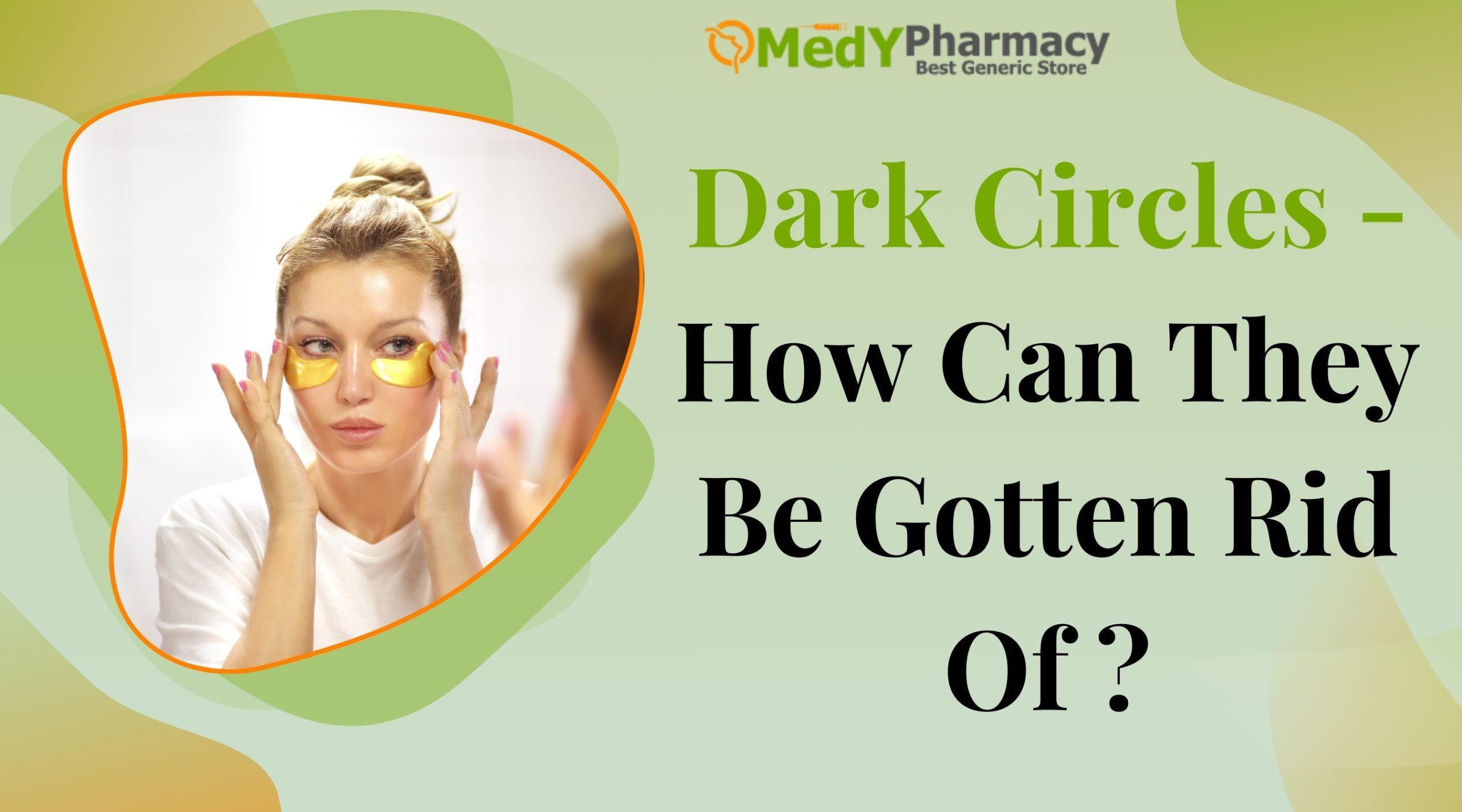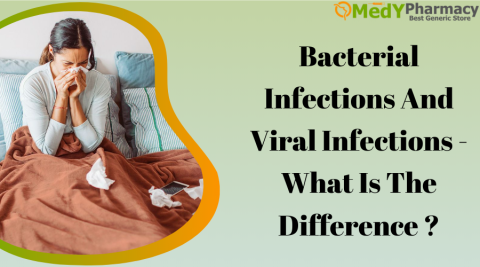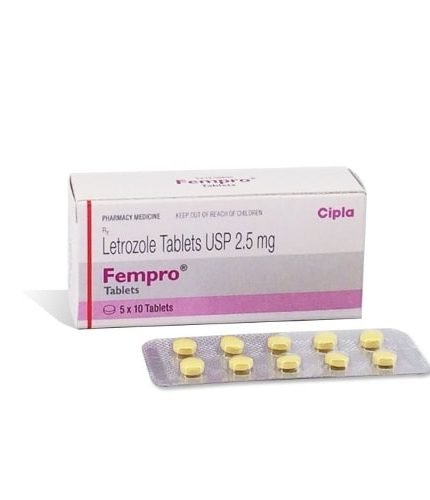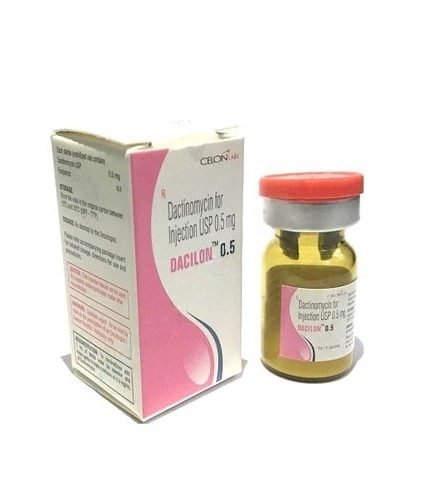Introduction:
Dark circles beneath the eyes are among the most prevalent issues many of us deal with from an early age. Those who are experiencing excessive stress, sadness, or anxiety are more likely to exhibit these problems.
This problem is present even in those who smoke a lot or are prone to drug, alcohol, or narcotic dependence. Sometimes aging is the only reason why black rings form.
However, there are easy ways to eliminate dark circles at home, along with lifestyle changes and other medications. If you’re not seeing any results immediately, you might want to see a skin specialist.
For people of all ages and genders, this is a typical cosmetic issue. The key to solving this problem is knowing the proper Dark Circle Ingredients, whether you want to start your skincare brand or are just searching for personal use items that work.
This may be reduced with the correct chemicals, making the skin look more renewed. In addition to these components, it’s critical to heed seasonal guidance, such as skincare recommendations for the summer and winter. It will be simpler to choose the ideal Dark Circle Ingredients for your skincare line after reading this advice.
Dehydration, allergies, age, lack of sleep, and heredity are some of the causes of dark circles beneath the eyes. Even with adequate sleep, you may appear exhausted and older than you are due to these bothersome under-eye shadows.
Although certain persistent ones may be difficult to eradicate because of their underlying causes, there are several efficient and scientifically supported methods to reduce their undesired presence. The sensitive eye region may be brightened and revitalized for a more alert, rejuvenated appearance with the correct focused treatments and lifestyle changes.
What is Dark Circle?
Increased pigmentation, thinner skin, and vascularity around the eye region are the results of several variables that combine to develop this condition. Due to the loss of collagen and flexibility caused by aging, blood vessels become more noticeable, giving the skin a darkish look. Sleep deprivation may make this problem worse by creating puffiness and fluid retention, which can highlight dark circles.
By selecting the finest under-eye cream for dark circles, these issues may be specifically addressed and a younger, more radiant eye region can be encouraged.
This serious problem with appearance affects both men and women of all ages. You may appear worn out, aging, and lifeless due to these annoying shadows beneath your eyes. Despite their generally benign nature, they frequently induce self-consciousness. Learn about the reasons, kinds, and home treatments for dark circles to get rid of them and keep them from returning by reading on.
All of these fixes are just short-term, though. Your under-eyes can be brightened, lifted, and plumped with a variety of in-clinic treatments if you’re searching for something more durable and efficient.
You’re not the only one who finds dark circles bothersome, aggravating, and tough to completely remove. It’s typical to wish that the black circles beneath your eyes might be eliminated, and many people may end up searching online for ways to do so.
You may progressively get insecure if you are frequently asked if you’re tired while you’re feeling good or if others frequently think you’re older than you are. This may negatively affect your self-esteem. Alternatively, you may dislike dark circles and wish to eliminate them.
Look no further if any of that resonates with you; we have written a guide specifically for you that will walk you through practical dark circle removal techniques. We will look at a range of approaches, including home cures.
The Identification and Management of Melanin-Related Dark Circles
Melanin-related dark circles can occur on both the upper and lower eyelids and are frequently inherited if you have darker skin. You are naturally beautiful, and these are normal! Nevertheless, they may also be the consequence of outside influences like:
- Chronic irritation or eczema
- Excessive eye rub
- Allergic reaction-induced inflammation
When to See a Doctor about Issues with Dark Circles
Dealing with dark circles is crucial. Such problems are frequently brought on by bad eating habits and particular lifestyle choices. By speaking with the physicians, you can find the best treatment and treat the illness while it’s still in its early stages.
An underlying medical condition like allergies, anemia, or even a thyroid issue may be the cause of the dark circles if they develop quickly or get noticeably worse. These are combined with other eye-related symptoms like puffiness, redness, or discomfort, it may indicate an infection or another illness that requires medical care.
Changes in the texture or color of the skin behind your eyes, together with noticeable puffiness, may indicate a problem with your blood vessels, fluid retention, or even skin disorders like eczema. If you’ve made lifestyle adjustments and the circles don’t get better, it might be worthwhile to consult a physician to look into any underlying issues.
Causes of Dark Circles
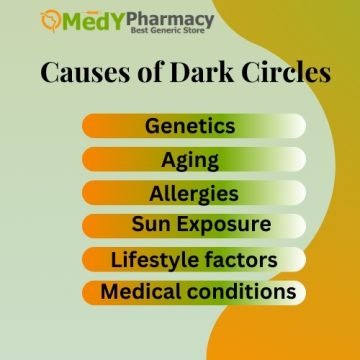
- Genetics
These are mostly hereditary, and because of your family history, you may be more susceptible to them or have them from birth. In such situations, the inherent structure of your face that creates shadows there or thinner skin behind your eyes can also lead to dark circles.
Although heredity is a major factor, sleep deprivation can exacerbate dark circles. Taking care of any allergies you may have might help reduce dark circles.
Eating a healthy, vitamin-rich diet and drinking plenty of water might occasionally make the look better. Specifically made for the under-eye region, these creams and serums frequently contain retinol, hyaluronic acid, or caffeine, which may enhance skin texture or lessen puffiness.
In order to address the underlying skin concerns, some people choose to get chemical peels, laser therapy, or fillers if the dark circles are a major source of discomfort.
- Aging
This can undoubtedly also be caused by aging. The natural thinning and loss of collagen in the skin behind our eyes as we age can highlight blood vessels and give the area a darker, sunken appearance. Furthermore, changes in facial muscle tone and fat loss might cause the region behind the eyes to slightly droop, making shadows more obvious.
Maintaining adequate moisture in the area beneath your eyes will help prevent the skin from being too thin and lessen the visibility of fine wrinkles. Look for creams that have a lot of peptides or hyaluronic acid, which can help make the skin look plumper. Although you may wish to use sparingly around the sensitive eye area, retinol, can increase the formation of collagen and enhance skin thickness over time.
To increase volume to the under-eye region and lessen the shadow impression, some people use dermal fillers. Others use laser treatments to enhance the texture and color of their skin. Even if aging cannot be prevented, minimizing the visibility of dark circles can still be achieved by controlling stress and obtaining adequate sleep.
- Allergies
Sometimes known as “allergic shiners,” can be caused by allergies. Your nose may expand and become inflamed as a result of your body’s reaction to allergens. This may result in dilating blood vessels surrounding the eyes, intensifying dark circles.
Treating the underlying allergy is your best bet. Both topical and oral antihistamines can aid in lowering inflammation and discomfort. Seeing a doctor for testing to determine what’s causing your responses might be worthwhile if you’re not sure which allergies you have.
Rubbing your eyes when they’re itching can worsen irritation and dark circles, I know it can be difficult. For comfort, if your eyes are irritating, think about applying an eye drop. People swear by these natural methods to relieve the region beneath their eyes. Tea bags’ caffeine may aid in blood vessel constriction, and the cooling helps soothe the skin.
- Sun Exposure
Sunlight exposure can exacerbate dark circles, particularly as it thins the skin and intensifies pigmentation beneath the eyes. When exposed to the sun, the sensitive skin behind your eyes is more susceptible to UV damage and may darken, making dark circles more obvious.
Wearing sunglasses with UV protection can help avoid squinting, which can lead to wrinkles and fine lines, as well as UV damage to the skin around your eyes. To provide additional protection for the region around your eyes, you may also wish to search for eye creams or moisturizers with SPF. Avoiding exposure to the sun during peak hours, when UV rays are highest, can help avoid additional darkening and damage to the skin.
- Lifestyle factors
The skin behind your eyes may seem more pale or lifeless when you’re not getting enough sleep, which makes the blood vessels beneath them more noticeable. Try to get 7 to 9 hours of good sleep every night.
Occasionally, sleeping on your side or stomach might result in fluid retention around your eyes, which can create dark circles and puffiness. Try resting your head slightly up as you sleep on your back.
This may result from low iron levels, so be sure to consume enough iron-rich foods, such as lean meats, spinach, and lentils. One may find themselves scratching their eyes due to allergies or just eye strain. Avoid this since it might aggravate the sensitive skin behind your eyes and bring out dark circles.
- Medical conditions
These are frequently caused by allergies, as we previously discussed. They cause the blood vessels around the eyes to widen and become inflamed, which can give the impression of dark circles. Dark circles and puffiness around the eyes can result from this illness, which is caused by allergies that inflame the nasal passages.
Prolonged dehydration can make your skin appear dry and lifeless, highlighting and enlarging dark circles. Maintaining healthy skin and minimizing its look requires proper hydration. To rule out any medical concerns, it can be worthwhile to consult a healthcare professional if you’ve observed that your dark circles are getting worse or if they’re accompanied by other symptoms. They may recommend blood testing or other diagnostic procedures to identify the underlying cause of the problem.
The pigmentation of the skin, especially the area around the eyes, might alter as a result of hormonal changes that occur during pregnancy, menstruation, or menopause. This might become more obvious as a result.
How Can I Find the Best Dark Circle Curing Products?
We strongly advise you to speak with the doctors to determine which lotions and other cosmetic products are most effective in treating dark circles. One such option that is open to you is the use of sunscreen.
However, since you might not be aware of the safety of these products or how much of them to take, it is safe to state that consulting a doctor can help you prevent any negative consequences.
It is best to speak with a skilled dermatologist in your community because most people have varied skin tones and textures. Some of us have extremely sensitive skin, so using any lotion or gel might not be enough to reduce dark circles. On the contrary, their usage may result in adverse consequences.
For skin tightening and fluid retention reduction, look for treatments that include peptides or caffeine. Products containing vitamin C, niacinamide, or licorice extract can brighten and even out the tone of your skin if your dark circles are more pigmented or the result of sun damage.
Blood vessel visibility can be decreased by thickening the skin and encouraging the creation of collagen with the use of peptides, hyaluronic acid, and retinol. For those who like a thicker, more hydrating consistency, a cream may be a better option. Although serums may be lighter and more deeply enter the skin, they may not provide as much moisture. It may be more helpful to use a cream if your skin is dry.
Some formulations have a metal roller tip in addition to the active chemicals, which can assist reduce puffiness and offer an instant cooling feeling. It might be helpful to contact a dermatologist if you’re still unclear or would want more personalized advice. These are more potent than over-the-counter alternatives, they might propose prescription items or treatments. They can also advise professional treatments like laser therapy or chemical peels.
Is It Possible For Dryness And Dullness Beneath The Eyes To Result From Improper Skincare Practices?
A poor skin care regimen might result in dullness and dryness beneath the eyes. Dryness and discomfort can result from the sensitive skin behind your eyes losing moisture if you don’t moisturize it frequently and seek tailored treatments.
Furthermore, the lack of nourishing ingredients and insufficient protection from harsh environmental conditions can cause a dull, exhausted appearance, which exacerbates fine lines and dark circles under the eyes.
For dull and dry under eyelids, a well-planned skincare regimen that incorporates moisturizing products and gentle care is therefore essential to preserving the health of the skin.
Dark Circles Associated with Blood Vessels
This beneath the thin skin surrounding the eyes becomes more prominent, resulting in visible blood vessel dark circles, also known as vascular dark circles. The thinness of the skin under the eyes is often the cause of this, since this may more readily show through, giving the region a bluish or purple hue. There are a few solutions that can help lessen the look of these dark circles, however, they can be very difficult to cure.
Although sunscreen might not be able to immediately address blood vessel-related dark circles, shielding the sensitive area behind your eyes from the sun might stop more pigmentation and skin thinning. It is crucial to wear sunscreen every day since the sun’s damaging rays can make dark circles more noticeable.
To lessen the appearance of dark circles brought on by blood flow, a cold compress or cooled gel mask might temporarily constrict blood vessels. Additionally, by reducing puffiness, the cooling impact might make you look more rested.
Types of Dark Circles
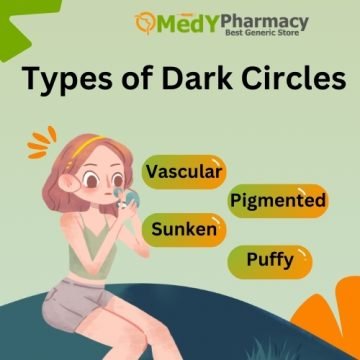
- Vascular Dark Circles
These black circles, which are the most prevalent kind, are brought on by blood vessels that protrude through the thin skin behind the eyes. Depending on your skin tone, they frequently seem reddish, purple, or blue.
Poor circulation, thin skin, and heredity can all make blood vessels more obvious. Lack of sleep, allergies, and sinus problems can all make this kind worse by causing swelling or inflammation around the eyes, which makes blood vessels much more noticeable.
Products containing retinol, hyaluronic acid, caffeine, or peptides should be selected. Fillers and laser treatments can also be beneficial since they thicken the skin and make blood vessels less visible.
- Pigmented Dark Circles
Excess melanin behind the eyes is the cause of these dark, reddish, or brownish circles. Those with medium to dark complexion tones tend to have them more prominent.
Age, heredity, and sun exposure can all cause the under-eye region to produce more melanin. Pigmentation might also result from eye rubs.
Over time, brightening agents such as arbutin, licorice extract, niacinamide, and vitamin C can help lessen pigmentation. Eye treatments containing peptides and caffeine can help improve skin tone and circulation, while sunscreen is essential for preventing additional darkening.
- Sunken Dark Circles
Deep shadows or hollows beneath the eyes are the appearance of these dark circles. Because the skin loses volume and fat with age, they could become more obvious.
The causes of hollow dark circles include aging, muscular weakness, and fat loss under the eyes. Additionally, the form of the eye region may be influenced by genetics.
The hollowed-out look can be lessened by using dermal fillers to restore volume beneath the eyes. Enhancing the texture of the skin and giving the under-eye region a plumper appearance can also be achieved by moisturizing and using retinol-containing products.
- Puffy Dark Circles
The eyes seem bloated and exhausted due to the puffiness or swelling that goes along with these circles. The shadow created by the puffiness is often what causes the darkening.
Sleep issues, allergies, fluid retention, and even nutrition can cause puffiness. Genetics may predispose certain persons to fluid retention behind the eyes.
Coffee is an excellent way to reduce puffiness since it constricts blood vessels. Extra fluid can also be drained with the use of cold compresses, peptide-based eye lotions, and light massage. To avoid puffiness, cut back on salt, drink plenty of water, and get better sleep.
Do Skin Disorders Like Melasma and Eczema Lead to Dark Circles?
Yes, dark circles under your eyes might indeed be caused by some skin disorders and allergies, such as eczema and melasma. To cure such diseases, you can apply topical medicinal ointments or visit a physician to utilize the appropriate combination of medications.
Dark, discolored areas on the skin, usually on the face, are a symptom of melasma. It usually results from an excess of melanin, which is frequently brought on by hormonal fluctuations, exposure to the sun, or certain drugs.
Dark circles that are brown or grayish may come from pigmentation problems caused by melasma that affects the under-eye region. As a result, the skin surrounding the eyes may seem darker or uneven.
Eczema is a skin disorder that results in skin inflammation, redness, and itching. It can impact the sensitive skin surrounding the eyes, among other sections of the body.
The under-eye region may experience dryness, irritation, and even discoloration as a result of inflammation or excessive rubbing and scratching when eczema strikes. This may make dark circles look worse. In addition to causing the skin around the eyes to thin over time, chronic eczema can also make dark circles more obvious.
In both situations, treating the underlying ailment might lessen the visibility of dark circles. It’s a good idea to see a dermatologist for individualized guidance and treatment if eczema or melasma is causing dark circles.
How Can I Get Rid of Dark Circles With Skin Care Products?
To find out the dosage for any lotion, brightening gel, or other ointment used to treat dark circles, it is essential to speak with a dermatologist.
It’s crucial to use just enough of these creams and gels to cover the dark circle areas around the eyes rather than too much.
This may appear more noticeable on skin that is dehydrated. Hydrating eye treatments can help plump up the face, which will make dark circles less obvious. Numerous eye treatments include it, which can help increase blood flow and lessen puffiness and discoloration beneath the eyes.
In particular, if pigmentation is the culprit, sun exposure might exacerbate dark circles. Regularly applying sunscreen helps shield the sensitive skin behind your eyes from UV rays and stop it from getting darker.
It may be worthwhile to see a dermatologist to discuss alternative options, such as laser treatments or chemical peels for obstinate pigmentation, if dark circles continue after applying topical treatments, even though skincare products can make a considerable impact.
Essential Components to Consider
Knowing the vital components that can successfully address dark circles beneath the eyes is crucial while looking for the finest under-eye cream.
- Caffeine
Having anti-inflammatory qualities, caffeine minimizes the appearance of dark circles by reducing puffiness and narrowing blood vessels. In addition to improving blood circulation, it can lighten the region behind the eyes.
Caffeine, a vasoconstrictor, helps narrow the blood vessels behind the eyes, minimizing swelling, puffiness, and the blue-is hue caused by dilated veins and capillaries that show through. Additionally, it possesses anti-inflammatory qualities to reduce swelling under the eyes and antioxidant qualities that prevent the development of pigments that cause discoloration.
The whole eye region is rebuffed by caffeine, which also helps to remove extra fluid. By reducing pigmentation, bags, and shadows simultaneously, it produces a bright, alert appearance.
- Retinol
A vitamin A derivative, retinol boosts collagen synthesis and cell turnover, which helps to thicken the skin beneath the eyes. Over time, this can enhance skin texture and lessen the appearance of dark circles.
Retinoids cause pigmented surface cells to shed and enhance cell turnover, which eventually lightens dark circles and discolored patches. Additionally, they thicken the dermis, which keeps the sensitive skin behind the eyes from displaying visible blood vessels underneath.
Dark circles seem worse because retinoid stimulates the development of collagen and elastin, which makes the region firmer, plumper, and stronger. Over time, retinoids, which are derivatives of vitamin A, decrease discoloration by optimizing the skin’s regeneration process. They are a powerful multipurpose tool for dark circle repair.
- Vitamin C
This antioxidant brightens the skin, lowers pigmentation, and shields it from environmental aggressors. It can improve the shine of the skin and lighten dark circles.
A strong antioxidant, vitamin C prevents the overproduction of melanin pigment, a primary cause of discoloration and dark circles beneath the eyes. Its brightening qualities aid in the area’s skin tone fading and evenness.
Furthermore, capillary walls are strengthened by vitamin C, which keeps them from penetrating the extremely thin skin under the eyes. This lessens the bluish-purple color that might result from dilated blood vessels.
By scavenging UV-induced free radicals, vitamin C also offers photoprotection, which helps prevent the under-eye region from gradually becoming thicker and darker. When taken consistently, it helps keep the complexion bright and even.
- Hyaluronic Acid
Hyaluronic acid, a potent humectant, seals in moisture and hydrates the sensitive skin behind the eyes. Because hydrated skin looks plumper, dark circles may appear less noticeable.
As a humectant, hyaluronic acid attracts and retains moisture from the surrounding environment. Because it can hold up to 1,000 times its weight in water, this molecule is an amazing skin hydrator. The natural amounts of hyaluronic acid in our skin decline with age, which can cause wrinkles, dryness, and a loss of plumpness.
Using hyaluronic acid regularly—ideally morning and night—is essential for significant benefits. Improvements may not be apparent for a few weeks. Seek out eye creams or serums with hyaluronic acid that are specially designed for the region beneath the eyes. For the sensitive skin around your eyes, these lotions are usually more concentrated.
- Peptides
These are short amino acid chains that increase skin suppleness and promote the synthesis of collagen. By increasing skin firmness, peptides might lessen the visibility of dark circles.
Acetyl tetrapeptide-5 and acetyl hexapeptide-8 are two examples of peptides that block the synthesis of circadian pigment, which stops melanin from clumping and discoloring beneath the eyes in the first place. They can lighten and lighten existing pigmentation and darkness beneath the eyes over time.
Peptides disrupt the melanogenesis process of the skin at different stages, producing both short-term and long-term effects. They achieve long-lasting brightness beneath the eyes via deeper disruption of pigment production.
- Niacinamide
Niacinamide is a kind of vitamin B3 that brightens and smoothes the skin. Additionally, it helps alleviate puffiness and dark circles by reducing redness and irritation.
Because of its anti-inflammatory qualities, which lessen puffiness and inflammation that cause the skin around the eyes to darken, niacinamide, a kind of vitamin B3, can be used to treat dark circles around the eyes. By fortifying the skin’s barrier function, it keeps moisture from escaping and shields the sensitive eye region from external stresses that might worsen dark circles.
Niacinamide helps to lessen dark circles and hyperpigmentation by blocking the transfer of melanin. It also targets dark circles brought on by thin skin or inadequate blood circulation by enhancing microcirculation around the eyes. By neutralizing free radicals and shielding the skin from oxidative stress—another cause of dark circles—niacin amide’s antioxidant qualities help prevent dark circles.
- Licorice Extract
Hyperpigmentation can be lessened by this natural ingredient’s lightening qualities. Because it relaxes and soothes the skin, licorice extract is perfect for sensitive regions.
Licorice extract works especially well for dark circles brought on by too much melanin and other forms of hyperpigmentation. To lighten dark spots and balance the skin tone, it contains glabridin, a substance that blocks the enzyme that produces melanin. It is therefore a great component for lessening the visibility of pigmentation-induced dark circles.
Because licorice extract acts gradually, you might not see effects right away. It may take a few weeks of regular use before you notice a decrease in the darkness of your circles, particularly if pigmentation is the culprit.
- Arnica
Arnica, which is well known for its therapeutic qualities, helps improve circulation and lessen bruises. It might be especially helpful for dark circles brought on by exhaustion or trauma.
A well-known natural herb for its ability to reduce inflammation, ease pain, and promote healing is arnica. The plant that produces it, Arnica Montana, is frequently used topically to alleviate muscular soreness, bruising, and swelling. In skincare treatments for sensitive or irritated skin, arnica extract is frequently used to aid healing and decrease inflammation.
For dark circles brought on by fluid retention or swelling beneath the eyes, arnica is very beneficial. By lessening puffiness, dark circles may appear more noticeable. The skin around the eyes might seem less puffy and more even-toned by using arnica to soothe and reduce inflammation.
Are There Possible Side Effects When Using Creams to Treat Dark Circles?
Using certain lotions may indeed cause some small negative effects. That’s why we previously advised you to see a doctor before using any skincare products.
Generally speaking, problems with skin peeling, swelling, inflammation, redness, itching, and burning are some of the most typical signs that you have overdosed on your cream.
Either your overuse of the cream or the inclusion of a generic ingredient that you shouldn’t use are the possible causes.
These creams and skincare products can indeed work, but there are some possible negative effects to be mindful of. Using new items should be done with caution since the skin behind the eyes is fragile and delicate. If the product irritates you, cease using it right away. You might try using it less often or use a softer product made for skin that is more sensitive.
Therefore, as you can see from this post, we have included the top products to treat dark circles around your eyes. We’ve also covered some crucial natural and home methods for dark circles removal.
To individuals who are prepared to investigate Medypharmacy and develop a solution specifically designed to address dark circles.







